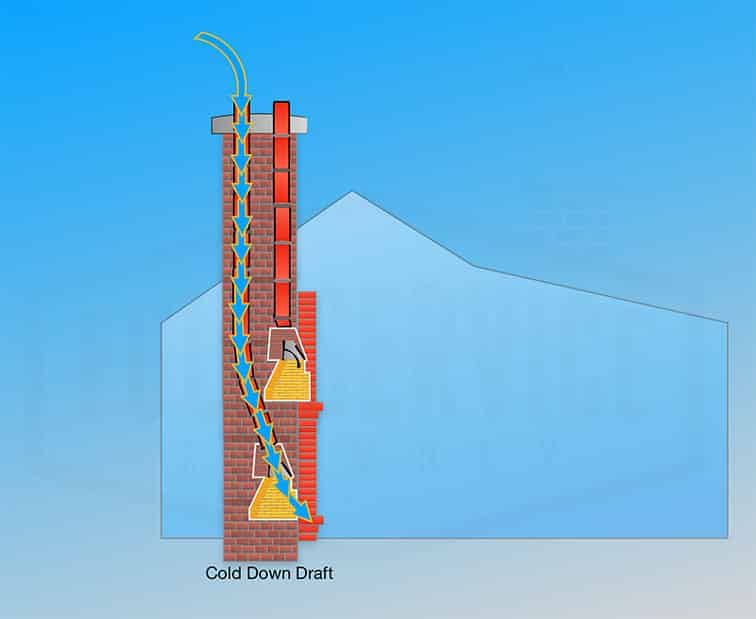Page Contents
Quick Answers
There are a few options you can use to block or reduce drafts coming from your fireplace:
- Install draft stoppers – These attach to the fireplace opening and seal when not in use.
- Use a chimney balloon – An inflatable balloon that seals the chimney flue when not in use.
- Install glass fireplace doors – Closes off the firebox when not in use.
- Use a fireplace plug – A large inflatable plug that seals the fireplace opening.
- Install flue damper – A metal plate that seals the chimney flue when closed.
The most effective options are glass doors or a flue damper since they create an airtight seal. Draft stoppers and chimney balloons help reduce drafts but don’t fully block them.
What Causes Drafts From a Fireplace?
Drafts from a fireplace are caused by air flowing down the chimney and into the home. There are a few reasons this happens:
- Temperature difference – When the inside of the home is warmer than the outside, air will flow up and out the chimney. Cooler outside air then gets drawn down the chimney and into the home, causing a draft.
- Wind – Strong winds blowing across the chimney create pressure differences that pull air down the chimney.
- Chimney height – Taller chimneys create more airflow, resulting in stronger drafts.
- Flue open – An open damper or lack of flue blocker allows air to freely move up and down the chimney.
Understanding what causes drafts can help you pinpoint solutions, like installing a chimney cap to reduce wind effects or a flue damper to seal the chimney when not in use.
Fireplace Draft Stopper Options
Here are some common options for blocking drafts coming from your fireplace:
Chimney Pillow or Balloon

A chimney pillow or balloon is an inflatable plug that fits into the flue opening. When inflated, it seals the chimney to prevent airflow.
Pros:
- Easy to install and remove
- Relatively inexpensive
- Compact for storage when not in use
Cons:
- Does not create an airtight seal
- Can deflate over time and need reinflating
- Some models prone to punctures
Cost: $20 – $60
Fireplace Draft Stopper

Draft stoppers sit in front of the fireplace opening to seal it off. Most attach via adjustable rods or strips that fit the opening.
Pros:
- Creates decent seal when fitted properly
- Convenient to install and remove
- Inexpensive
Cons:
- Gaps can allow some airflow
- May not work well for irregular shaped openings
- Can be bulky
Cost: $20 – $80
Fireplace Plug

A fireplace plug is a large inflatable stopper that seals the firebox. They come in various shapes and sizes.
Pros:
- Creates tight seal when inflated
- Easy to insert and remove
- Good for large openings
Cons:
- Prone to deflation over time
- Can be punctured by fireplace hardware
- Bulkier storage
Cost: $30 – $100
Glass Fireplace Doors

Glass doors seal the front of the firebox when closed. Most include screens or grates to provide ventilation when open.
Pros:
- Provides air-tight seal
- Allows view of fire when open
- Wide range of styles
- Durable if tempered glass
Cons:
- Can be expensive
- Not adjustable to fit irregular openings
- Glass can get very hot
Cost: $100 – $2,000
Chimney Flue Damper

A flue damper is a metal plate installed at the flue opening that seals when closed. It prevents airflow when fireplace not in use.
Pros:
- Creates an airtight barrier
- Out of sight when installed
- Low maintenance
Cons:
- Must be professionally installed
- Not adjustable for chimney size
- Can jam or malfunction over time
Cost: $150 – $300 installed
Tips for Choosing a Fireplace Draft Blocker
Here are some tips for selecting an effective fireplace draft stopper:
- Measure the opening size to get right fit
- Prioritize airtight materials like rubber or vinyl
- Match style to your fireplace décor
- Consider ease of use and installation
- Choose durable materials if children or pets
- Get professionally installed options like glass doors or dampers for best seal
- Examine reviews and warranties on inflatable products
- Test draft stopping power once installed
- Supplement with additional draft sealing if needed
Taking precise measurements and factoring in lifestyle needs will help narrow the choices. Testing for drafts after installation ensures the solution is effectively blocking air. Supplemental sealing like weatherstripping may be needed for complete draft prevention.
Conclusion
Unwanted drafts from a fireplace can make rooms feel chilly and uncomfortable. Luckily, there are several effective options to stop fireplace drafts and prevent heat loss up the chimney.
The right solution depends on your budget, fireplace design, and blocking power needed. Inflatable products provide a quick, affordable fix while installed products like glass doors or dampers create the best seal. Combining a couple solutions can also optimize draft prevention.
With some simple annual maintenance like checking inflatables for air leaks or lubricating damper hinges, a well-chosen draft blocker will keep your rooms cozy and comfortable for years to come. Evaluating your fireplace setup and lifestyle needs will point you toward the best draft stopper for your home.
